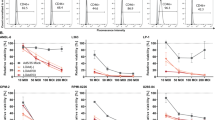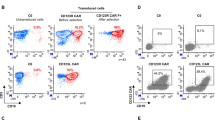Abstract
In patients with chronic myelogenous leukemia (CML), abnormal expansion of myeloid cells is maintained by expression of the p210bcr-abl fusion protein. Thus, this protein and its mRNA represent primary targets to inhibit proliferation of these cells. Here we describe the properties of a ribozyme against the bcr-abl mRNA, expressed as a fusion transcript with the human U1 small nuclear RNA or the adenovirus VA1 RNA and delivered to the cells through retroviral vectors. These fusion ribozymes are specifically localized in the nucleus or in the cytoplasm, respectively. Transduction of 32D-LG7 myeloid cells, whose growth is IL-3 independent thanks to deregulated bcr-abl expression, imposed strong negative selective pressure on cell growth and induced restoration of an IL-3–dependent phenotype. Although expressed at a level similar to that of the U1-fusion ribozyme, the cytoplasmic VA1 ribozyme was a more powerful inhibitor of p210bcr-abl gene expression. In cells transduced with the vector expressing this ribozyme, the levels of the bcr-abl transcript were reduced up to 104-fold, the p210bcr-abl protein became undetectable, and the cells underwent massive apoptosis when cultured in the absence of IL-3. Transduction of primary hematopoietic cells obtained from bone marrow of patients with CML resulted in remarkable reduction of bcr-abl mRNA levels, starting a few days after transduction. These results show the feasibility and efficacy of vector-expressed anti–bcr-abl ribozymes for purging of CML cells.
This is a preview of subscription content, access via your institution
Access options
Subscribe to this journal
Receive 12 print issues and online access
$259.00 per year
only $21.58 per issue
Buy this article
- Purchase on Springer Link
- Instant access to full article PDF
Prices may be subject to local taxes which are calculated during checkout









Similar content being viewed by others
References
Shtivelman E, Lifshitz B, Gale RP et al. Alternative splicing of RNAs transcribed from the human abl gene and from the bcr-abl fused gene Cell 1986 47: 277–284
Heisterkamp N, Stam K, Groffen J et al. Structural organization of the bcr gene and its role in the Ph′ translocation Nature 1985 315: 758–761
Kurzrock R, Gutterman JU, Talpaz M . The molecular genetics of Philadelphia chromosome-positive leukemias N Engl J Med 1988 319: 990–998
Litzow MR, Tefferi A . Bone marrow transplantation for chronic myelogenous leukemia Blood 1994 83: 2752–2753
Reiffers J, Goldman J, Meloni G et al. Autologous transplantation in chronic myelogenous leukemia: European results: Chronic Leukemia Working Party of the EBMT Bone Marrow Transplant 1994 14: S51–S54
Carella AM, Lerma E, Corsetti MT et al. Autografting with philadelphia chromosome-negative mobilized hematopoietic progenitor cells in chronic myelogenous leukemia Blood 1999 93: 1534–1539
Khouri IF, Kantarjian HM, Talpaz M et al. Results with high-dose chemotherapy and unpurged autologous stem cell transplantation in 73 patients with chronic myelogenous leukemia: the MD Anderson experience Bone Marrow Transplant 1996 17: 775–779
Kantarjian HM, Giles FJ, O'Brien S et al. Therapeutic choices in younger patients with chronic myelogenous leukemia Cancer 2000 89: 1647–1658
Bhatia R, Verfaillie CM, Miller JS et al. Autologous transplantation therapy for chronic myelogenous leukemia Blood 1997 89: 2623–2634
Deisseroth AB, Zu Z, Claxton D et al. Genetic marking shows that Ph+ cells present in autologous transplants of chronic myelogenous leukemia (CML) contribute to relapse after autologous bone marrow in CML Blood 1994 83: 3068–3076
Degliantoni G, Mangoni L, Rizzoli V . In vitro restoration of polyclonal hematopoiesis in a chronic myelogenous leukemia after in vitro treatment with 4-hydroperoxycyclophosphamide Blood 1985 65: 753–757
Carlo-Stella C, Mangoni L, Almici C et al. Autologous transplant for chronic myelogenous leukemia using marrow treated ex vivo with mafosfamide Bone Marrow Transplant 1994 14: 425–432
Barnett MJ, Eaves CJ, Phillips GL et al. Autografting with cultured marrow in chronic myeloid leukemia: results of a pilot study Blood 1994 84: 724–732
Szczylik C, Skorski T, Nicolaides NC et al. Selective inhibition of leukemia cell proliferation by Bcr-abl antisense oligodeoxynucleotides Science 1991 253: 562–565
Ledley FD . Nonviral gene therapy: the promise of genes as pharmaceutical products Hum Gene Ther 1995 6: 1129–1144
Wagner RW . Gene inhibition using antisense oligodeoxynucleotides Nature 1994 372: 333–335
Keating A, Wang XH, Laraya P . Variable transcription of Bcr-abl by Ph+ cells arising from hematopoietic progenitors in chronic myeloid leukemia Blood 1994 83: 1744–1749
Leopold LH, Shore SK, Reddy EP . Multi-unit anti–Bcr-abl ribozyme therapy in chronic myelogenous leukemia Leuk Lymphoma 1996 22: 365–373
Snyder DS, Wu Y, McMahon R et al. Ribozyme-mediated inhibition of a Philadelphia chromosome-positive acute lymphoblastic leukemia cell line expressing the p190 bcr-abl oncogene Biol Blood Marrow Transplant 1997 3: 179–186
Wright LA, Milliken S, Biggs JC et al. Ex vivo effects associated with the expression of a bcr-abl–specific ribozyme in a CML cell line Antisense Nucleic Acid Drug Dev 1998 8: 15–23
Kuwabara T, Warashina M, Tanabe T et al. A novel allosterically trans-activated ribozyme, the maxizyme, with exceptional specificity in vitro and in vivo Mol Cell 1998 2: 617–627
Sullenger BA, Cech TR . Tethering ribozymes to a retroviral packaging signal for destruction of viral RNA Science 1993 262: 1566–1569
Rossi JJ . Controlled, targeted, intracellular expression of ribozymes: progress and problems Trends Biotechnol 1995 13: 301–306
Snyder DS, Wu Y, Wang JL et al. Ribozyme-mediated inhibition of bcr-abl gene expression in a Philadelphia chromosome-positive cell line Blood 1993 82: 600–605
James H, Mills K, Gibson I . Investigating and improving the specificity of ribozymes directed against the bcr-abl translocation Leukemia 1996 10: 1054–1064
Prislei S, Buonomo SB, Michienzi A et al. Use of adenoviral VAI small RNA as a carrier for cytoplasmic delivery of ribozymes RNA 1997 3: 677–687
Armentano D, Yu SF, Kantoff PW et al. Effect of internal viral sequences on the utility of retroviral vectors J Virol 1987 61: 1647–1650
Tafuro S, Zentilin L, Falaschi A et al. Rapid retrovirus titration using competitive polymerase chain reaction Gene Ther 1996 3: 679–684
Laneuville P, Heisterkamp N, Groffen J . Expression of the chronic myelogenous leukemia-associated p210bcr/abl oncoprotein in a murine IL-3 dependent myeloid cell line Oncogene 1991 6: 275–282
Chomczynski P, Sacchi N . Single-step method of RNA isolation by acid guanidium thiocyanate–phenol–chloroform extraction Anal Biochem 1987 162: 156–159
Shifman MI, Stein DG . A reliable and sensitive method for non-radioactive Northern blot analysis of nerve growth factor mRNA from brain tissues J Neurosci Methods 1995 59: 205–208
Raap AK, van de Rijke FM, Dirks RW et al. Bicolor fluorescence in situ hybridization to intron and exon mRNA sequences Exp Cell Res 1991 197: 319–322
Celi FS, Zenilman ME, Shuldiner AR . A rapid and versatile method to synthesize internal standards for competitive PCR Nucleic Acids Res 1993 21: 1047
Grassi G, Zentilin L, Tafuro S et al. A rapid procedure for the quantitation of low abundance mRNAs by competitive RT-PCR Nucleic Acids Res 1994 22: 4547–4549
Diviacco S, Norio P, Zentilin L et al. A novel procedure for quantitative polymerase chain reaction by coamplification of competitive templates Gene 1992 122: 3013–3020
Giacca M, Pelizon C, Falaschi A . Mapping replication origins by quantifying relative abundance of nascent DNA strands using competitive polymerase chain reaction Methods 1997 13: 301–312
Sambrook J, Fritsch E, Maniatis T . Molecular Cloning — A Laboratory Manual Cold Spring Harbor, NY: Cold Spring Harbor Laboratory Press 1989
Kuwabara T, Warashina M, Nakayama A et al. Activities of tRNA-embedded dimeric minizymes Nucleic Acids Symp Ser 1997 37: 307–308
Ilves H, Barske C, Junker U et al. Retroviral vectors designed for targeted expression of RNA polymerase III–driven transcripts: a comparative study Gene 1996 171: 203–208
Wang FS, Kobayashi H, Liang KW et al. Retrovirus-mediated transfer of anti-MDR1 ribozymes fully restores chemosensitivity of P-glycoprotein–expressing human lymphoma cells Hum Gene Ther 1999 10: 1185–1195
Laneuville P, Sun G, Timm M et al. Clonal evolution in a myeloid cell line transformed to interleukin-3 independent growth by retroviral transduction and expression of p210bcr/abl Blood 1992 80: 1788–1797
Lecoeur H, Ledru E, Prevost MC et al. Strategies for phenotyping apoptotic peripheral human lymphocytes comparing ISNT, annexin-V and 7-AAD cytofluorometric staining methods J Immunol Methods 1997 209: 111–123
Smetsers TF, Skorski T, van de Locht LT et al. Antisense Bcr-abl oligonucleotides induce apoptosis in the Philadelphia chromosome-positive cell line BV173 Leukemia 1994 8: 129–140
Sullenger BA, Lee TC, Smith CA et al. Expression of chimeric tRNA–driven antisense transcripts renders NIH 3T3 cells highly resistant to Moloney murine leukemia virus replication Mol Cell Biol 1990 10: 6512–6523
Zhou C, Bahner IC, Larson GP et al. Inhibition of HIV-1 in human T-lymphocytes by retrovirally transduced anti-tat and rev hammerhead ribozymes Gene 1994 149: 33–39
Bertrand E, Castanotto D, Zhou C et al. The expression cassette determines the functional activity of ribozymes in mammalian cells by controlling their intracellular localization RNA 1997 3: 75–88
Michienzi A, Prislei S, Bozzoni I . U1 small nuclear RNA chimeric ribozymes with substrate specificity for the Rev pre-mRNA of human immunodeficiency virus Proc Natl Acad Sci USA 1996 93: 7219–7224
De Young MB, Kincade-Denker J, Boehm CA et al. Functional characterization of ribozymes expressed using U1 and T7 vectors for the intracellular cleavage of ANF mRNA Biochemistry 1994 33: 12127–12138
Montgomery RA, Dietz HC . Inhibition of fibrillin 1 expression using U1 snRNA as a vehicle for the presentation of antisense targeting sequence Hum Mol Genet 1997 6: 519–525
Guthrie C, Patterson B . Spliceosomal snRNAs Annu Rev Genet 1988 22: 387–419
Carmo-Fonseca M, Tollervey D, Pepperkok R et al. Mammalian nuclei contain foci which are highly enriched in components of the pre-mRNA splicing machinery EMBO J 1991 10: 195–206
Good PD, Krikos AJ, Li SX et al. Expression of small, therapeutic RNAs in human cell nuclei Gene Ther 1997 4: 45–54
Pe'ery T, Mellits KH, Mathews MB . Mutational analysis of the central domain of adenovirus virus–associated RNA mandates a revision of the proposed secondary structure J Virol 1993 67: 3534–3543
Ma Y, Mathews MB . Secondary and tertiary structure in the central domain of adenovirus type 2 VA RNA I RNA 1996 2: 937–951
Mellits KH, Mathews MB . Effects of mutations in stem and loop regions on the structure and function of adenovirus VA RNAI EMBO J 1988 7: 2849–2859
Furtado MR, Subramanian S, Bhat RA et al. Functional dissection of adenovirus VAI RNA J Virol 1989 63: 3423–3434
Robbins PB, Yu XJ, Skelton DM et al. Increased probability of expression from modified retroviral vectors in embryonal stem cells and embryonal carcinoma cells J Virol 1997 71: 9466–9474
Zentilin L, Qin G, Tafuro S et al. Variegation of retroviral gene expression in myeloid cells Gene Ther 2000 7: 153–166
Fu DJ, McLaughlin LW . Importance of specific purine amino and hydroxyl groups for efficient cleavage by a hammerhead ribozyme Proc Natl Acad Sci USA 1992 89: 3985–3989
Acknowledgements
We thank Maria Elena Lopez for excellent assistance in tissue culture and Barbara Boziglav for skillful technical support. We are very grateful to Irene Bozzoni for the VA1 plasmid, to Maria Alessandra Santucci for the 32D and 32D-LG7 cell clones, and to Eli Gilboa for the N2A vector.
Author information
Authors and Affiliations
Corresponding author
Rights and permissions
About this article
Cite this article
Mendoza-Maldonado, R., Zentilin, L., Fanin, R. et al. Purging of chronic myelogenous leukemia cells by retrovirally expressed anti–bcr-abl ribozymes with specific cellular compartmentalization. Cancer Gene Ther 9, 71–86 (2002). https://doi.org/10.1038/sj.cgt.7700410
Received:
Published:
Issue Date:
DOI: https://doi.org/10.1038/sj.cgt.7700410
Keywords
This article is cited by
-
Ribozyme-mediated inhibition of survivin expression increases spontaneous and drug-induced apoptosis and decreases the tumorigenic potential of human prostate cancer cells
Oncogene (2004)
-
BCR/ABL: from molecular mechanisms of leukemia induction to treatment of chronic myelogenous leukemia
Oncogene (2002)



